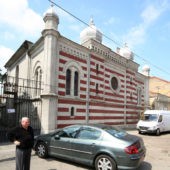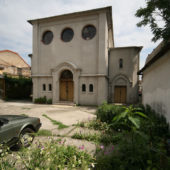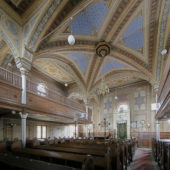With a striped Italian Renaissance style facade facing the street, the entrance is from an interior courtyard.
The first documented Jewish presence in Timisoara is in 1716. However, in the old Sephardic cemetery, there is a grave of a Rabbi and surgeon, Azriel Assael, dating back to 1636. A century later, Rabbi Meir Amigo and four of his protégé were allowed to move into the city from Istanbul. After the implementation of the Astro-Hungarian citizens’ rights acts, the Jewish community in Timisoara thrived, achieving a population of nearly 7,000 people. After 1867, six synagogues were built in the city; three remain, although only this one is presently in use. After 1948, many Jews emigrated to Israel. Due to emigration and the Holocaust, today there are only 400 Jews left in Timisoara.
Completed in 1910, the Recita Synagogue is of eclectic Renaissance design. The northern façade of the building, which sits flush with the street, features brick red and concrete white horizontal bands, with tall arched windows, a flower shaped window at the top center of the building, a central gable, crowning central dome and surrounding cupolas. The bulbous three-foiled arches of the upper windows and the shape of the cupolas are distinctly Moorish. The clear separation between the stories, and pillars, colonettes, bases, shafts, capitals, as well as the interior moldings are indicative of Neoclassical styling. The interior of the Synagogue is striking, with soaring ceiling arches tapering down into columns for the second story balcony, supported by another set of columns on the ground floor. While the exterior walls of the building are masonry, the interior load bearing columns are steel or cast iron, typical of the era of the building’s construction.
The arches and ceiling are intricately decorated with moldings and hand-painted light blue and various shades of tan and blue. The women’s balcony, which is situated against the back and side walls, features beautifully carved panels and balustrades. The pews are also skillfully carved of wood. The bimah is situated on a platform at the East end of the prayer-room, before the Aron-Kodesh. The tivah (reader’s desk) sits on the bimah and a beautifully worked iron and wood balustrade surrounds the platform, with an entrance on either side, with four white, spherical lights arising from the four corners of the bimah, held aloft by beautifully worked iron stands. The Aron-Kodesh is beautifully carved from wood, in a Moorish styling and painted ivory with gilded highlights. There is a Hebrew inscription across the top, with an ivory and gold pelmet, and a deep green Torah curtain embroidered in gold and red. Atop the Aron-Kodesk are two tablets, inscribed in Hebrew with The Ten Commandments. There is a round Star-of-David window just above the Aron-Kodesh, with another large Star-of-David painted above it in light blue and tan, and two others painted just like it flanking either side of the Aron-Kodesh. Carved wood paneling adorns the lower wall on either side of the Aron-Kodesh.
The Synagogue continues to serve its community for Shabbat and High Holidays. The community is comprised mostly of those who follow the neolog rite, but some are orthodox. According to a congregation member, “somehow we work things out together.”



